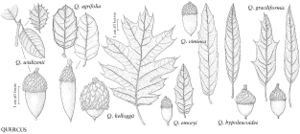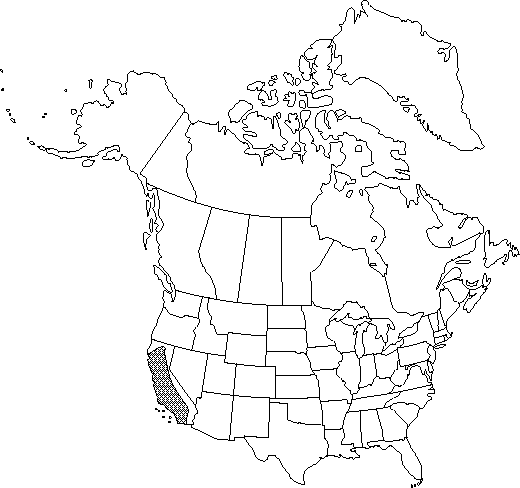Quercus wislizenii
in A. P. de Candolle and A. L. P. de Candolle, Prodr. 16(2): 67. 1864.
Trees or shrubs, evergreen, to 22 m. Bark nearly black, deeply furrowed with broad scaly ridges. Twigs brown to red-brown, 1.5-3 mm diam., glabrous or sparsely pubescent. Terminal buds light chestnut brown to dark reddish brown, ovoid to conic, 3-9 mm, glabrous or with tuft of minute hairs at apex. Leaves: petiole 3-20 mm, glabrous or sparsely pubescent. Leaf blade circular to oblong, usually ovate, planar, 25-70 × 20-50 mm, base obtuse to cordate, margins entire or spinose with up to 16 awns, apex acute to rounded; surfaces abaxially and adaxially glabrous, veins little raised on either surface. Acorns biennial; cup deeply and narrowly cup-shaped or U-shaped, 9-19 mm high × 7-18 mm wide, covering 1/3-1/2(-2/3) nut, outer surface glabrous to sparsely puberulent, inner surface glabrous or pubescent on innermost 1/3, occasionally uniformly pubescent, scales acute, tips loose; nut narrowly conic or ovoid to narrowly oblong, 21-44 × 8-14 mm, glabrous, scar diam. 2.5-7.5 mm. 2n = 24.
Phenology: Flowering late spring.
Habitat: Valleys, slopes, and sand chaparral
Elevation: 300-1900 m
Discussion
Shrubs with oval leaves 25-38 mm and margins entire or deeply lobed-dentate may be treated as Quercus wislizenii var. frutescens. J. M. Tucker (1993) treated Q. parvula as a distinct species, distinguished from Q. wislizenii by its larger leaves (30-90 versus 20-50 mm), by the dull, olive-green, abaxial leaf surface (versus shiny, yellow-green), and by nuts that are abruptly tapered proximal to the middle (versus gradually tapered).
Tucker recognized two varieties of Quercus parvula: Q. parvula var. parvula is a shrub of 1-3 m and Q. parvula var. shrevei is a tree less than 17 m. S. K. Langer (1993) recognized a third variety, Q. parvula var. tamalpaisensis,based on several small populations on or near Mount Tamalpais, differentiated primarily by having larger leaves (50-160 × 20-60 mm) with attenuate-dentate margins.
Quercus wislizenii reportedly hybridizes with Q. agrifolia and Q. kelloggii (W. B. Brophy and D. R. Parnell 1974).
Selected References
None.

